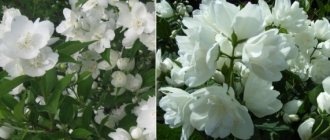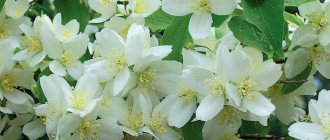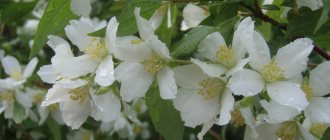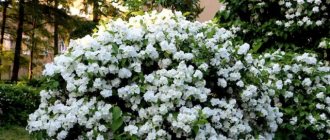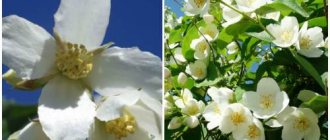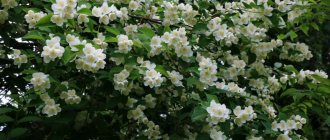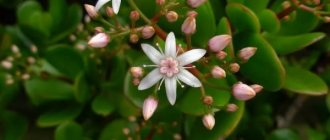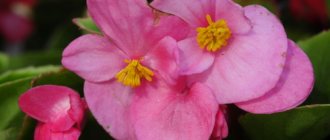Jasmine, or mock orange, is highly decorative and can be grown at home or in the garden. Most often, the plant has beautiful white flowers. Due to this, it is often used in landscape design.
With proper care, jasmine blooms magnificently
Many people are interested in what year after planting jasmine blooms. The timing of the beginning of flowering directly depends on the variety. This usually occurs between 2 and 4 years of age.
However, there is no guarantee that the crop will bloom at this age. Growing conditions may not be suitable for the crop, which will lead to bud drop. In such a situation, it is necessary to organize care for the jasmine bush so that it can bloom.
The flowering period depends on the variety of shrub:
- spring - bloom from early spring to late summer;
- summer - flowers appear from June and persist until the first frost;
- winter - bloom from the beginning of the year to mid-spring.
The growing region is also important. So, in the Moscow region, flowers will appear earlier than in Siberia, but later than in the southern regions. When planting, you need to know how many years it takes for jasmine to begin to bloom.
Differences in the flowering of garden and indoor jasmine
The main feature of a houseplant is the presence of a period of winter dormancy. Flowering can last from early spring until autumn. When grown at home, flowers are present for 3 weeks. Then they fall off, and the bush forms new shoots.
Important! Indoor jasmine has a strong smell, which can cause headaches. Therefore, the container with the culture should be taken out to another room overnight.
Indoor jasmine has a dormant period.
Features of planting
In order for mock orange to bloom magnificently and for a long time in the garden, it is important to plant it correctly. To do this, you need to choose the right place, prepare the soil, and also plant it correctly in open ground.
Mock orange will bloom for 50 years if it is watered in a timely manner, the soil is plowed, fertilized, mulched, branches are pruned, and protected from pests.
Deciding on a landing site
Stagnant moisture and saline soils with groundwater negatively affect mock orange. Therefore, it is recommended to plant the plant on fertile and moist soil. This is the kind of place that will help the mock orange develop and bloom. There are also plant species that can grow in soil with unfavorable environmental conditions.
Jasmines can bloom even in the most shaded places. But they bloom best in partial shade. To admire the flowers of the plant every year, it is recommended to plant mock orange in sunny areas.
Preparing the ground
The soil for mock orange should be fertile and well permeable. It is recommended to cover clayey areas with a drainage layer: sand, broken brick or expanded clay. Sandy areas can be further diluted with compost or vermicompost. The pits for mock orange are filled with a peat mixture with humus, sand and tree leaves. Immediately before planting, it is recommended to add mature humus to the soil. A little fresh manure can be added to the soil in the fall.
Heavy soil can be lightened by adding weathered peat.
Features of planting mock orange
It is recommended to plant young plants as follows:
- Two-year-old seedlings are considered the best planting material.
- If you plan to plant plants in groups, the distance between them should be 1.5 - 2 meters. If a single-row jasmine hedge is planned, seedlings are planted every half meter.
- When planting, the root collar can be deepened a couple of centimeters into the soil. If it is placed more than three centimeters deeper, the plant will rot.
- The size of the planting holes should be more than 40x40x40 centimeters.
- In order for valuable mock orange varieties to take root better, they can be fertilized with Zircon or HB-101.
- Before planting seedlings in open ground, remove broken and dried branches and roots. Distribute the roots evenly in the center of each hole. Cover with moist, nutritious soil and water well. Every bush needs a bucket of water. It is recommended to water the bushes every three days for 14 days after planting. Then the bushes are watered as needed.
Basic resuscitation and prevention measures
Mock orange does not bloom, you need to know what to do and how to restore health to the plant in order to prevent problems in time. In order for any plant to delight with buds, it is necessary to provide it with proper care, planting and replanting. The flower should be watered regularly, fertilized with minerals and loosened the soil.
Regular and terry species must be processed taking into account the following rules:
- The plant should be fertilized twice during the growing season. To improve flowering, it is necessary to add potassium-based fertilizers. In summer, fertilize with phosphorus compounds. It is best to choose liquid fertilizers.
- Garden jasmines are pruned in July. Thickened shoots should be removed so that the young ones can develop normally. They don’t forget about rejuvenating the bush. If the plant is more than 10 years old, the branches must be removed at the root. This procedure provides a powerful stimulation of flowering and further growth.
- Before wintering, the soil must be mulched with peat or pine needles to a depth of 3-4 cm.
- When jasmine blooms, it is necessary to carry out preventive treatment against pests.
The year in which mock orange blooms depends on the propagation method, as well as on care conditions. The more accurately a person follows the instructions, the better for the flower. And the greater the chance that it will decorate the garden with fragrant inflorescences.
Why does jasmine grow poorly?
Without waiting for beautiful fragrant flowers, pay attention to whether the shrub itself is developing normally. The absence of young shoots, bare branches, slow growth in height and volume of green mass - all this indicates a disruption in the process of its growth.
The reasons for delayed development are the same as for the lack of flowering: incorrectly chosen planting site, lack of light, moisture or nutrients. But correcting growth defects is much more difficult, and the process takes longer. Increased feeding should be carefully combined with sanitary pruning or even complete rejuvenation of the bush.
Improper watering
Improper watering is one of the most common reasons for the lack of flowers on your jasmine. The fact is that the structural features of the leaf do not allow us to see the plant’s true need for water. The bush doesn’t turn yellow, the leaf blades don’t dry out, but you won’t get flowers
To avoid mistakes in moisturizing, remember that jasmine, so common in our latitudes and familiar to the eye, is still a tropical plant by nature. An average healthy bush requires at least a bucket of water every 3 days. This is provided that the soil around the tree trunk is loosened, free from weeds and mulched.
Errors when fertilizing
Underfeeding and overfeeding with fertilizers are equally dangerous for flowering shrubs and lead to the absence of flowers. At the time of flower bud formation, liquid fertilizers with potassium are additionally applied.
Jasmine itself loves minerals, but they need to be applied no more than 2 times a year: during the period of active leaf bloom and in the fall, when the plant gains strength for wintering, approximately September - early October.
Wrong landing site
In order for jasmine to delight you with flowering, it is important to immediately choose the right place to plant this capricious plant. The main contraindications are stagnant moisture, groundwater, damp and swampy areas. Under these conditions the bush grows poorly.
Clay soils are not suitable, but if necessary, you can prepare a planting hole by laying at least 20 cm of drainage: crushed stone, pebbles, expanded clay or river sand with broken bricks. Heavy soil can be diluted with weathered peat, and if the soil on the other hand is too sandy, then it is enriched with mature humus.
No sanitary pruning
Jasmine, like no other plant, needs regular sanitary pruning, otherwise the bush very quickly, literally within one season, thickens with young shoots and disappears into a green mass. This not only spoils the decorative appearance of the plant, but also prevents it from blooming.
1- shortening faded shoots to a healthy bud; 2- shortening strong growths; 3- removal of dry and damaged branches
In the spring, every year, before the buds awaken, remove branches growing inside the bush, violating the strict pattern of the crown, as well as shoots weakened and damaged after wintering. At the same time, you need to trim the tallest branches growing upward.
Remember that any excessive pruning can also cause a lack of flowering for more than one year. Experienced gardeners recommend adhering to the 25% rule: the total volume of all trimmings per year should not exceed 1/4 of the green mass of the bush.
For the mock orange to bloom
Rules for formation and care
So one of the most beloved garden shrubs, symbols of the Russian garden, the mock orange, has bloomed. And it is at this time that the important moment comes in preparing it for flowering next year. In order for this shrub to delight us with a large number of white fragrant flowers year after year, we should take care of it in early July.
Most often, our gardeners grow a shrub called garden jasmine - crown mock orange, which came to ornamental gardening from Western Europe. This plant has also earned high praise from gardeners in our region, since many of its varieties winter well without any shelter.
The mock orange blooms after the spring riot of ornamental plants - Hungarian lilac, buldenezh viburnum, hawthorn. Perhaps it is precisely because of this that the mock orange so easily became a symbol of the Russian garden - for a long time it simply had no competitors. Mock orange flowers are very fragrant, mostly white, sometimes cream, arranged singly or in racemose groups. Often they completely cover the branches of the bush. The aroma fills the entire garden, spreading for many meters around. Thanks to breeding work, there are currently varieties Belle Etoile and Unusual with the presence of pink in the corolla of the flower.
Variety Belle Etoile. Originator Lemoine, 1930. Shrub height – 1.5 m. Flowering – July. The climate zone is 5, so it often freezes in our area. The flowers are simple white with a purple eye. The aroma is sweet but weak. Grows well in sun and light shade.
Variety Belle Etoile in the garden of collector A. Schenev.
Variety Unusual. Originator N.K. Vekhov, 1961. Shrub height - 1.5 m. Flowers are dull white with a purple center, 2.5-3 cm in size with a strawberry aroma.
Classic wild mock orange is quite easy to grow, but achieving success in cultivating varieties is much more difficult. Many of them have thinner branches, they are inferior to wild shrubs in growth, and are more demanding in terms of agricultural technology and wintering conditions. Unfortunately, some of the most beautiful foreign varieties are completely unsuitable for our climate zone.
Site selection. Mock orange grows very quickly. This is a light-loving plant - it practically does not bloom in the shade. But the mock oranges Zolotisty and Innosens, planted in the shade, will not yet fully demonstrate their merits. This way, their brightly colored foliage will remain green in the shade. But the mock orange variety Variegata, on the contrary, does not feel very comfortable in the open sun, since its variegated leaves burn under strong rays. This variety is best grown in partial shade.
Mock orange Golden in my garden
Variety Golden (common mock orange golden form). Dense, slow-growing shrub reaching 1.5 meters in diameter. Often wider than tall. When grown in a sunny position until mid-summer, its foliage is lime green or yellow; after flowering it turns light green and turns yellow again in the fall.
Variety Innocence in the garden of collector A. Schenev.
Variety Innocence. Originator Lemoine. The height of the bush is 2.5 m. Flowering is at the end of June. Climatic zone – 4, relatively frost-resistant. Shrub with a spreading crown. The flowers are white, semi-double and fragrant. The leaves are green with cream and yellow streaks.
Variety Variegata in the garden of collector A. Schenev.
Variety Variegata (common mock orange, variegated form). Originator Lemoine. A very decorative shrub with exquisite, very variegated foliage and flat, round, fragrant white flowers. Shade-tolerant and frost-resistant.
Soil and fertilizing. Mock orange prefers light, humus soil that does not dry out in the sun. Therefore, drainage work should be carried out in the locking areas. To do this, broken brick, crushed stone and sand are placed at the bottom of the planting pit. The thickness of the drainage layer should be approximately 15 cm. Then the hole is filled with a mixture of humus, leaf soil and sand. If the soils on your site are sandy and dry out easily, you should add a mixture of peat, humus and clay to the planting hole. You can use a special water-retaining gel as an additive.
Due to annual pruning and strong growth, mock orange requires a fairly large amount of nutrients. Therefore, it is useful to feed him. It is better to allocate time for this in the spring at the beginning of leaf formation. Mock orange plants respond very favorably to the application of both organic and complex mineral fertilizers. In the spring, several buckets of rotted manure or compost can be added under the mock orange bush, and after flowering, nitroammophoska, superphosphate or ash can be scattered to stimulate shoot growth.
It is better to mulch the soil under the bush with any organic material - mown grass, leaf litter, peat, humus, rotted sawdust, wood chips or pine bark.
Winter hardiness. When choosing mock orange, be sure to inquire about its winter hardiness. For the most part, mock oranges are quite winter-hardy, withstanding frosts down to -25°C. However, some modern varieties of mock orange still freeze out. Most varietal mock oranges are not cold-resistant enough - some freeze slightly in harsh winters with little snow (White Bouquet, Charm, Belle Etoile), others are afraid of late spring frosts. During severe winters in our region, they can freeze out until the snow cover, although they are then quickly restored. For example, the Avalanche (Avalanche) variety, also called Strawberry, freezes already at minus 15°C. But the adapted variety Snow Avalanche is resistant to the middle zone climate. The beautiful terry variety Virginal often freezes.
Mock orange Strawberry in my garden
Of particular interest are winter-hardy mock orange varieties bred by breeder-dendrologist Nikolai Kuzmich Vekhov (1887-1956), who headed the Lipetsk Experimental Breeding Station for 30 years. These include: Chamomile, Yunnat, Moth Ballet, Snowballs, Pearls, Arctic Moonlight, Academician Komarov, Kazbek, Airborne Assault, Obelisk, Snowstorm, Zoya Kosmodemyanskaya, Pompom, which deserve wider distribution in ornamental gardening.
Variety Pearl in the garden of collector A. Schenev.
Variety Zoya Kosmodemyanskaya in the garden of collector A. Schenev.
Trimming. In order for mock orange to bloom abundantly every year, it needs regular pruning. The fact is that good flowering is observed only on strong shoots from last year. On thin and weak old shoots, flowers will also appear, but they will be small and there will be few of them. Many old shoots do not bloom at all and make the bush look sloppy. Therefore, after flowering, it is necessary to remove faded branches to the strong shoots of this year located below. After a while, you will notice that the young growth left behind from this year has become vigorous. Next year they should bloom profusely.
Remove all branches older than two to three years, as well as weak, damaged and frozen ones. Too long young branches can be shortened by trimming the thin tops.
After rejuvenation, the bush needs to be hilled and fed, and in dry summers it needs to be watered abundantly.
Reproduction. Mock orange can be propagated by dividing the bush, but this procedure often involves replanting a huge bush, which is extremely undesirable and even inconvenient. It is much easier to obtain planting material from your favorite variety in the form of layering or rooted cuttings.
For layering, you can use fairly large branches, which are bent to the ground and covered with soil. After some time they will develop their own roots, after which they can be cut off from the mother plant and allowed to develop on their own.
If you need to obtain a large amount of planting material, for example for a hedge, then the most convenient method of propagation is green cuttings. The most favorable period for this is the time after flowering, when young growths appear. These are the ones that are used for rooting. To do this, they are broken out with the heel and placed in water for several days. After this, they are planted in a special bed for rooting.
In 2011, the Russian Chubushnik Society was created, which aims to promote this culture in Russia.
Transfer. Mock oranges tolerate transplantation quite easily and recover very quickly. In order to painlessly move an old large mock orange bush, you will have to sacrifice part of the crown and, therefore, lose a year of flowering. You can replant from early to mid-September or early spring. Before digging up a shrub, it needs to be watered abundantly and left for a day to allow it to gain moisture. After this, half of the old shoots should be removed to the very root, and the remaining ones should be shortened. Then you can dig up and move the mock orange to a new place, not forgetting to again water abundantly and compact the soil after planting.
What to do if jasmine does not bloom on your property or at home
The absence of buds in a plant over 3 years old is a signal to the gardener that he is not caring for it correctly. To restore the condition of jasmine, it is necessary to carry out a number of measures to eliminate negative factors:
- normalize watering - it should be frequent, but without overwatering;
- change, if necessary, the location - diffused light or partial shade is needed;
- change fertilizers. If only nitrogen substances were introduced, it is necessary to alternately use mineral and organic feeds;
- normalize cropping. It should be regular, held in autumn and spring.
If the jasmine is on the street and all measures to resuscitate it have been in vain, it needs to be transplanted. Perhaps it's all about the soil being poor in nutrients and minerals.
Jasmine will thank you for comfort with delicate, beautiful petals.
Other Possible Flowering Problems
In addition to the lack of buds, the gardener may encounter such phenomena as their too small size or their premature shedding.
Shedding of buds
How to propagate garden jasmine in spring and summer
Jasmine can drop buds prematurely under the influence of the following factors:
- Draft or strong wind.
- Use for cold water irrigation.
- Untimely and incorrect transplantation, when the plant has already begun to produce buds.
- Dry soil, lack of nutrients and minerals.
- Incorrectly selected fertilizer or its use in excessive quantities, which causes the roots to burn.
- Lack of lighting.
Jasmine may drop its buds because the room is too hot or exposed to direct sunlight.
Additional Information! It is recommended to plant jasmine outdoors in partial shade or in a place where the lighting is good but diffuse. It is especially necessary to follow this recommendation when planting a plant in the Moscow region, where summers can be very hot.
Small flowers
Varieties of mock orange with large inflorescences include:
- Mont Blanc;
- Pyramid;
- Schneeshturm;
- Zoya Kosmodemyanskaya;
- Virgin;
- Coronary.
Owners of jasmine with large inflorescences may encounter a problem such as insufficient bud size. This is due to improper care of the plant:
- frequent drying out of the soil;
- absence or insufficient pruning, due to which the plant puts all its energy into the growth of new shoots;
- insufficient refills or their incorrect choice;
- unfavorable location of the plant in the country - the influence of a draft or strong wind, stagnation of moisture.
Establishing care will help normalize the condition. If the plant is in a draft or exposed to direct sunlight, replanting will be required.
Attention! Transplantation is prohibited during the period when jasmine is actively putting out new buds.
Why doesn't garden jasmine bloom?
Alexandra » Dec 06, 2014, 09:19
Re: Why doesn't mock orange (jasmine) bloom?
Elol » 06 Dec 2014, 15:38
Re: Why doesn't mock orange (jasmine) bloom?
by irin_z » Dec 06, 2014, 05:20 pm
Re: Why doesn't mock orange (jasmine) bloom?
Alexandra » Dec 08, 2014, 08:35
Re: Why doesn't mock orange (jasmine) bloom?
by Nadin » Dec 08, 2014 09:58
Maybe this terry variety is so capricious? My simple mock orange grows on sandy soil, so it is not only not fertile, but half with fragments of concrete pieces left over from the paved path of the former owners. The bush has grown very large and is sprouting new growth. But not only shoots, it also reproduces by seeds.
This bush is old, I will completely cut it down (or cut it out) in the spring.
And this bush grew from a seed. True, it grows on more fertile soil. But they both somehow manage without watering. Is it possible that we still have rain in the summer?
Re: Why doesn't mock orange (jasmine) bloom?
Elol » 08 Dec 2014, 11:02
In 7 years you have grown by only a meter?! Then he definitely doesn’t belong there. It’s hard to say what exactly is interfering, but I would remove it entirely from there, cut off the old shoots if possible, make cuttings from them, and plant the mother bush in 4 cardinal directions in my garden. It is not typical for mock orange to grow so slowly! It's not a matter of terry, the point is that for some reason he doesn't feel comfortable there.
Added after 1 minute 39 seconds:
Re: Why doesn't mock orange (jasmine) bloom?
Alexandra » Dec 09, 2014, 07:32
Mistakes when watering
If the soil in the garden is constantly wet, you should not plant jasmine there. In some cases, this situation can be corrected by ensuring good drainage. To do this, take gravel, pebbles and crushed stone. All materials are laid out at the bottom of the hole.
Why garden or indoor jasmine does not bloom and what to do
Lack of moisture also causes problems with flowering. Without water, the plant loses strength, first stops blooming, and then dies completely.
Note! The plant cannot bloom if it is grown from seeds. Such specimens produce buds only after 7-8 years of life.
Home care
In order for the plant to grow at home, its care should be as follows:
- The soil. She must be well prepared. If necessary, you can add deciduous clay soil or sand to the soil. You can also add a little peat.
- Lime or water. If it is not possible to add a little lime, the flower can be watered with oxidized water. The main thing is to never pour more water than it requires.
- In warm weather, place on the balcony. In warm regions, this type of flower is recommended to be planted in open ground. During the warm season, the leaves need to be sprayed with water regularly.
- Temperature. It is necessary to maintain the temperature. It should not exceed twenty-three degrees and fall below sixteen degrees Celsius.
- Fertilizer. The flower needs to be fed with all kinds of fertilizers. The important point is that this should be done no more than once every two weeks.
- Watering. The plant should be watered as often as the soil dries out, but no more than several times a week. In winter, watering is reduced significantly.
- Trimming. Shoots need to be pruned because this is the main factor for flowering. To begin with, dry areas of the plant are removed, followed by bare shoots.
- Light. If it is not possible to expose jasmine to light, an artificial source will suffice.
Diseases
Another reason why mock orange does not grow and does not produce flowers is various diseases. Most often they occur due to improper care, damage by fungi and viruses. It is not difficult to detect the presence of a disease if you carefully examine the plant. Often the first symptoms are visible immediately, as the leaves and shoots are the first to be affected. Initially, yellow spots appear, the foliage curls and dries out.
It is recommended to treat with fungicides or other antifungal agents. It is important to carefully inspect the areas of all jasmine, as damage to the lower shoots or roots is possible.
To avoid the occurrence of diseases, you must adhere to the following rules:
- Be sure to use drainage to avoid water stagnation.
- Grow the indoor plant in a container of suitable size.
- In winter, send the flower to rest.
- Prune annually.
- Monitor watering. Jasmine begins to shed its leaves if the soil is too wet or, conversely, dry.
- Provide normal humidity. Shoots dry out when humidity is low and the soil is completely dry.
- Use the right water. When using alkaline water, the twigs begin to dry out.
The presence of any problem will negatively affect the flowering of jasmine.
The absence of flowers in mock orange may indicate a lack of light. And if the buds have darkened, it means the air around is too dry and warm.
Gray rot on mock orange leaves
General information about the flower
In the middle zone, jasmine is grown exclusively as a houseplant. Since these liana-like shrubs are not frost-resistant and hardy in our conditions.
When choosing a support for a flower, it does not have to be large
To grow indoor jasmine, arches and supports are required, as it has long climbing shoots. All varieties of the crop have flowers that are collected in inflorescences. Depending on the type, the flowers are white, yellow, or pink.
Therefore, it is not recommended to place strong-smelling jasmine near the bed.
Preparing for winter
Its further growth and flowering depends on how the winter goes. Jasmine tolerates cold well, so there is no need to dig it up for the winter.
Covering the bush for the winter instead of digging it up is the right decision
Before the onset of severe frosts, the plant is covered and left to hibernate under the snow until spring. Sawdust, spruce branches or spruce branches are used for shelter. After winter, the bush is trimmed and frozen branches are removed.
Healing properties
Since parts of the plant contain salicylic acid, the plant is used as an anti-inflammatory agent.
Indoor jasmine is actively used in the preparation of medications that are used to treat diseases:
- Hepatitis;
- Cirrhosis of the liver;
- Gynecological diseases;
- Hypotension;
- Insomnia.
Jasmine is effectively used in aromatherapy , since the aroma of flowers has a beneficial effect on the nervous system, improving mood, normalizing sleep and suppressing depression.
Aromatherapy - a rare use for indoor flowers
Not only jasmine can help a person with health problems. See how Aloe Vera (Agave) helps against various ailments.
Thus, jasmine is a very beautiful and noble plant that will decorate any room design. In addition, the flowers of the plant have an incredible aroma. At the same time, jasmine is a very capricious crop, and caring for it requires serious skills in floriculture.
Varieties
There are more than 300 plant species in the world. We invite you to consider the most common ones. They may differ not only in appearance, but also in care features.
- Jasmine flattened. It is small in size. The leaves are lightish, lanceolate. This species has flowers of a delicate purple hue and a persistent aroma.
- Shrub jasmine. A shrub with flexible and smooth shoots. Grows in height up to 1.5 meters. Leaves are paired. Flowering in the form of half-umbrellas on the sides of the shoots.
- Jasmine Lerata. The adult species reaches 3.5 meters. Its stems have dark green leaves and small white buds with a mint aroma.
- Multi-flowered jasmine. Climbing plant. The leaves are covered with grayish hairs. Star-shaped flowers are collected in inflorescences and are located along the entire length of the shoots. Flowering occurs all year round. Has a pleasant aroma.
- Medicinal jasmine. A weaving plant with long shoots and paired smooth leaves located on them. The flowers are white, fragrant, located on stalks. This species is used for medicinal purposes.
- Jasmine sambac. A climbing species with leathery, oval-shaped leaves and white double flowers that have a very strong aroma. The buds are collected in clusters. Blooms all year round with good care.
- Chinese jasmine. It grows as a vine or shrub with shoots up to 10 meters and has white flowers with a pronounced aroma.
